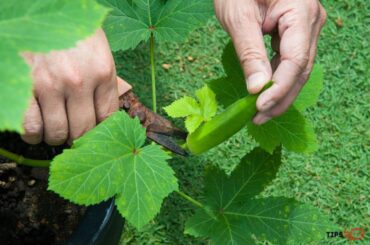Ceanothus plants are mainly popular for their attractive flowers. Besides, they would only require easy maintenance to grow. However, they would love to grow in similar conditions they get in their natural habitats. Californian Lilac and Wild Lilac are some of their common names. Moreover, Ceanothus plants are originally from North America and they belong to the family Rhamnaceae.
Ceanothus plants are fast-growing plants. So, after about 10-15 years they would usually lose shape and become sick. That being said, garden enthusiasts are big fans of these plants especially due to the unique foliage these plants have. Furthermore, anybody would fall in love with the breathtaking flowers they produce.
In terms of the sizes of the plants, most varieties would grow up to around 0.5-3 meters (2–10 feet) in height, that said varieties such as C. arboreus and C. thyrsiflorus would only reach heights of 6–7 meters (20–23 ft).

How to care for Ceanothus plants.
Sunlight requirements for Ceanothus plants
The Ceanothus plant would like to grow in sunny yet sheltered areas. That said, do not leave them exposed to harsh intense sunlight conditions as if you do so, it will make their leaves become discolored. Consequently, it will be difficult for them to thrive as well. If you grow them in a sheltered place chances are that they would survive for many years whilst producing some trouble-free flowers as well.
Water requirements for Ceanothus plants
Ceanothus plants are beautiful shrub-type plants that would prefer to have moist conditions to grow well. However, they would hate to grow in soggy conditions just like many other plant species. If the conditions are dry, you should consider watering them. On the other hand, when they are established, you can skip watering them. However if the weather conditions are too dry which would prevail for a longer period, you can water them moderately.
Soil requirements
When it comes to the right soil requirements, the most important factor you need to look for is drainage. That means you need to choose a well-draining soil mix. Don’t go for a poor draining soil mix as if you do so, it may lead to root rot. Furthermore, the selected soil mix needs to be fertile.
I don’t recommend using shallow chalky soil mixes since they will not provide sufficient enrichments for the Ceanothus plants. Consequently, they may suffer from chlorosis in these conditions as well. As a result of these conditions, you could see how their leaves become yellow between the veins.
Fertilizer requirements
I encourage you to apply a mulch layer, especially during late winter as it would be beneficial for the plants. However when you add the mulch layer ensure that you keep a few inches away from the plants so that it would avoid the potential of having any root rot which could take place. Moreover, I suggest you add slow-release fertilizers preferably during early spring. Besides, you may also add some blood fish and bone if you spot soil that seems to be less healthy.

How to plant the Ceanothus plants
First, you need to choose a position where there will be adequate sunlight and where they will be secure from strong winds. Keep in mind that the chosen soil should be well-draining. Next, dig a hole that would have a size of twice the width of the root ball. Next, sprinkle some organic fertilizers as well.
After that, you need to plant them in the pot and backfill the hole and add more soil around the roots to make the plant more stabilized. Next, you need to apply some water. Keep watering the plants until they establish more.
Maintenance
It is important that you provide some care for the Ceanothus plants once they are established. These plants can self-sustain once they are well established in their preferred growing conditions. In this aspect, if you happen to notice any frost or disease-damaged growth you need to remove them from the plants. Ceanothus plants don’t last for too long as aforementioned. However, if you manage to provide better care for them, they would survive for ten to fifteen years whilst rewarding you with some beautiful flowers.
With what other things Ceanothus plants would look good?
If we consider most of the varieties of Ceanothus plants, they will flower during late spring to early summer. So, I suggest you grow these plants along with late spring bulbs or even against a backdrop of spring flowering climbing plants such as with clematis Montana. Further, the medium-sized Ceanothus plants would make great for mixed borders.
How to prune the Ceanothus plants
First, keep in mind that pruning would vary depending on the variety of the Ceanothus plants. For example, if you have an evergreen Ceanothus plant, you don’t need to prune them on a constant basis. However, if you have young plants you could consider pinching their tips so that it would encourage them to develop a lush new growth of the plants. On other hand, if your Ceanothus plants have much longer branches, you could shorten them by half once they complete flowering.
Ceanothus plants don’t prefer to have harsh pruning in general. Further, you need to avoid cutting the older wood as the stumps would not grow back. Usually, the evergreen plants would not tolerate hard pruning and it would be somewhat difficult to renovate a shrub that has overgrown and become straggly as well. If you come across such a situation, ideally you need to replace the plant with a new one.
Suppose you have a flowering shrub as autumnal blue, then ideally you need to trim one-third of the plants during the spring. Usually, It is recommended to cut back the flowering shrubs during late spring and early summer to boost vigorous growth.
Ideally, you need to cut back one-third to one-half when pruning them. If you have Ceanothus deciduous plants such as Gloire de Versailles and Perle Rose, they will produce flowers every year. This literally means you can consider pruning them in spring so that it would encourage them to develop more flowering stems.

Flowering
Ceanothus are shrub plants with flowers that resemble lilacs. You could spot those flowers usually in blue. That said, they may also develop shades of deep indigo-colored shades too. Furthermore, there would be other Ceanothus varieties that would come up with pink and white too. So, if you are someone who wishes to add a colorful blooming plant, Ceanothus plants are the best choice.
Ceanothus plants produce flowers for around six weeks. Their flowering season would fall from late spring to early summer. Having said that, there could also be some Ceanothus plants that would blossom with flowers in July or August. If the Ceanothus plants don’t produce flowers, their small dark green colored leaves would act as attractive foliage for the plants. Furthermore, Ceanothus plant flowers are quite attractive to pollinators as well.
Ceanothus plants propagation
If you have deciduous Ceanothus plants, the best would be to propagate using their softwood cuttings ideally in late spring to mid-summer. If the weather was dry, I suggest you add some water right before you obtain their cuttings. Furthermore, ensure that you obtain the cuttings early in the day. Additionally, ensure that you choose healthy new growths and non-flowering shoots for propagation.
If you wish to use the cuttings,
You need first to obtain the cuttings which are about 10 cm ( 4 inches ) long. Further, ensure that you cut them off above the leaf bud as well. Next, simply pinch the soft tip and remove the leaves which are at the bottom part of the stem. Next, dip the stem cuttings in a rooting hormone powder and insert them in the holes you made in the pot whilst using a dibber or a pencil. Ensure that you use 4-inch pots for this purpose.
Next, you must mist them generously and cover the pots with a plastic bag. Thereafter, fix it with an elastic band. Furthermore, place the specimen in a sheltered position and where they will be protected from frost as well. in terms of sunlight, they need to ideally get bright indirect sunlight and not direct sunlight.
I suggest you remove the bag every week to water the plants. Consequently, it would allow the plants to absorb some fresh air as well. Further when you remove the bag, If you spot any dead or dying plant materials you could remove those as well. Lastly, you need to remove the bags at the very moment you spot them bearing new growths.
Semi-hardwood cuttings
Consider that you have evergreen Ceanothus plants, then the best thing you could do is to use semi-hardwood cuttings. The best time to conduct propagation would be mid-summer. That said, this propagation method would take a longer period to develop roots. These stems should stay hard enough when you try to bend them. I don’t recommend using old brittle wood as it would not turn out to be successful.
When selecting the semi-hardwood cuttings, they should ideally be healthy and have nice flowering side shoots. Furthermore, those cuttings need to be 7-15 cm in length as then you can obtain multiple cuttings from one shoot. When you make the cutting, you need to ideally use a clean sharp knife and cut it right below the leaf node. Ensure that those cuttings have at least a couple of nodes.
Thereafter you need to remove the soft tip and simultaneously remove the leaves from the lower third of the stem. After that, dip them in a rooting powder and locate them in the pot. Those pots need to be filled with some perlite as then it will enhance the draining in the pot. Next, you need to cover the pot with a plastic bag and make it firm by placing an elastic band. Lastly, you may place it where the specimen can gain bright indirect sunlight. Furthermore, make sure that you apply water to the specimen on a regular basis to keep them moist.

Ceanothus plants varieties
There are some Ceanothus plant varieties that would become so large as they grow older. So, you need to ideally check on the details of each variety and then start growing them if they suit your requirements. Furthermore, Ceanothus plants are mainly categorized into two sections such as evergreen and deciduous. You could commonly spot these deciduous plant varieties in the garden centers.
C. thyrsiflorus ‘Skylark’
C. thyrsiflorus ‘Skylark’ plants are medium-sized shrubs. Furthermore, they may tend to grow bushy as they grow. Besides, they may become glossy as well. Their leaves would carry teeth too. in terms of the sizes of the C. thyrsiflorus ‘Skylark’ plants, they would attain a maximum height of around 1.5-2.5 m ( 5-8 feet). When it comes to flowering of the C. thyrsiflorus ‘Skylark’ plants, you could spot them bearing flowering in deep blue during early summer.
C.Blue Mound
C.Blue Mounds are renowned for their blue-colored flowering. This is yet another evergreen Ceanothus plant variety that usually comes up with attractive oblong-shaped foliage. They would achieve a maximum height of 4-6 feet ( 1.2-1.8 m) when they grow to their fullest potential.
C.Autumnal blue
Autumn blue develops sky blue colored flowers from late summer to autumn. The lovely sky blue color of those flowers is breathtaking. Furthermore, these are large shrubs that would grow up to about 3 meters ( 10 feet ) in height.
C.Blue Sapphire
Blue sapphire inherits attractive foliage that would come up with a glossy dark green color. Besides, their foliage may carry bronze tinges too. They would grow in an arching habit and the flowers would form in mid-spring to late spring. They would be about 1-1.5 m ( 3-5 ) feet in height when at maturity.
C. Snow flurry
C. snow flurry grows in an upright manner. Further, they may comprise dark green colored leaves. Furthermore, they may also come up with white flowers during spring. What is special about these plants is that they can survive in heavier soil when compared with the other varieties. They would get as tall as 3 m ( 10 feet ) when they grow to their best potential.
C.arboreus ‘Trewithen Blue ‘
C.arboreus ‘Trewithen Blue plants are a large variety that could grow up to a maximum height of 6 m ( 20 feet) when they mature. Furthermore, they would produce flowers in deep blue inspires. Those flower blossoms would be about 12 cm ( 5 inches ). Apart from that, they would have a slight fragrance too.
C.delileanus Gloire de Versailles
C.delileanus Gloire de Versailles plants are medium-sized plants that would also grow in shrub types. Their leaves would be light green colored. Moreover, their blooms would be large and powder blue. They would reach a size of 1.5m ( 5 feet).
C. delileanus Henri Desfosse
C. delileanus Henri Desfosse plants are yet another vigorous variety that would carry oval-shaped leaves. They would be finely toothed as well. Besides, you could spot them developing dark blue flower spikes. Further, they would be about 1.5m ( 5 feet ) in size too.
C. Pallidus Perle Rose
If you are looking for an unusual rose pink plant variety, C. Pallidus Perle Rose would be the one to try out. It would produce flowers that are about 6 cm in length. When they reach maturity they would get as tall as 1.5, ( 5 feet).

Commonly spotted pest attacks of Ceanothus plants
Ceanothus plants can usually combat pests’ attacks quite well. That said they may still come across attacks from problems such as scales and honey fungus. If your plants happen to go through scale infestations, they may make the plants grow weakly. Additionally, it would make them drop the leaves as well. Scales usually have a waxy coating once they are mature. Due to that, it would be difficult for you to treat them. However, if the scales are immature you may consider treating them with pesticides. Keep applying them until you eradicate them from the plants unless they may reappear from time to time.
Diseases of Ceanothus plants
Ceanothus plants are susceptible to fungal attacks such as honey fungal attacks. They may tend to infest the roots of the woody Ceanothus plants. Once they attack you could see the fungal growth appearing on the bar as well as on the wood. This could turn out to be fatal to the plants too.
Once the plant’s roots go through this condition, it would make the plant’s roots unable to absorb water. Furthermore, they may come up with pale leaves and drop in flower blossoming too. Having said that, keep in mind that Ceanothus plants may rarely go through these conditions. Unfortunately, there are no chemical treatments for this and the best you could do is to destroy the plants entirely.
Conclusion
To wind up, Ceanothus plants are great plants to have and their beautiful flowers would catch anybody’s attention. If you manage to fulfill their basic growing requirements, they would reward you with beautiful plants in return. Apart from that Ceanothus plants have so many varieties to choose from depending on your wish as well.
Read Next : Epimedium Care And Propagation ( Easy Guide )




